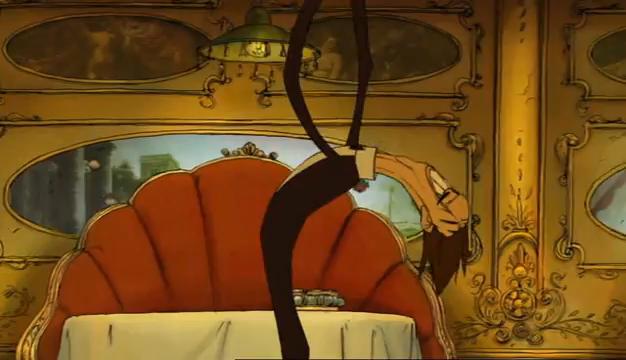We at Seattle Screen Scene find ourselves deep in preparation for the Seattle International Film Festival (we’re planning extensive coverage, look for our preview sometime early next week), but before we start rolling that out, here’s our Featured Film of the week, Sylvain Chomet’s 2003 Oscar nominee for Best Animated Film, The Triplets of Belleville. Like that year’s Oscar winner, Finding Nemo, the movie is about a parent searching for their lost child, questing through a strange and wondrous world, having adventures and finding help along the way. But otherwise the two films couldn’t be more different, Bellville abandoning the impressive photo-realism of Pixar’s crisp computer images for a highly stylized reality, bodies and shapes distended and distorted in extreme art nouveau parodies of pale yellows, browns and greens, earthy and bilious, daring you to call it ugly.
It opens, as all great films do, with a cartoon. A black and white parody of the 1930s Warner Bros animated shorts that featured celebrity caricatures, with a Django Reinhardt (who looks weirdly like William Powell), a Josephine Baker (the men in the audience, transformed by the eroticism of her dance, turn into psychotic monkeys who rush the stage and steal all the bananas off her skirt) and Fred Astaire who tap dances right out of his shoes, which then grow mouths and devour him like carnivorous Cronenbergian beasts. Right away you know you’re in for something special.

The quest plot follows a woman’s search for her grandson. He’s kidnapped while cycling in the Tour de France and she (along with his faithful dog Bruno) follow his abductors to the city of Belleville, a version of New York City. She’s aided in the search by the eponymous trio, elderly jazz musicians (they sang in the opening cartoon, in their youth) who find rhythm in unlikely household objects and have questionable dietary practices. Food is actually pretty disgusting throughout the film, a part of Chomet’s twin critiques of French and American culture: America is fat and disgusting, the source of overcrowded and soulless modernity; France is pretty gross too, but at least has an appreciation for the finer things in life like wine, jazz and bicycling.
Almost entirely lacking in dialogue (what there is it isn’t necessary to translate), the film is nevertheless resolutely aural, every effect a calculated addition to the symphonic whole, following in the tradition of Jacques Tati (even if you didn’t know Chomet would go on to adapt Tati’s The Illusionist, the reference is obvious: Belleville prominently features a M. Hulot’s Holiday poster, a weather vane in the shape of Tati from Jour de fête and even an actual clip from that same film (in which Tati plays a bicycle-riding mailman)). Similarly, while severely distorted, the bodies in the film follow a ruthlessly inviolable logic: giant mobsters with huge upper bodes and tiny legs dwarf the cars they ride in, as they stand through the sun-roofs of those cars in the final chase sequence, the balance of the vehicle is thrown off and sharp turns cause them to flip over, the villains doomed by their own enormity; a maitre’d so literally spineless in his obsequity that he literally leans over backwards, his head flopping back-to-front and side-to-side. What appears to be simple chaotic weirdness is in fact carefully constructed and calculated to achieve a specific effect, which I guess is a reasonably good definition of jazz.
A wickedly funny, strangely poignant and wildly inventive film, The Triplets of Belleville plays Friday through Tuesday this week at the Central Cinema, whose clever programmers have paired it with another classic about bicycling, the 1986 Hal Needham BMX film, Rad, with Lori Laughlin.


One thought on “The Triplets of Belleville (Sylvain Chomet, 2003)”
Comments are closed.